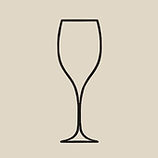Champagne's pink fly
- Luiz Bernardes

- May 13, 2022
- 2 min read
The term "whitefly" is used to refer to something difficult to find, something rare. Today's theme is about one of these flies, the pink fly and illustrious unknown AOC Rosé des Riceys. The best-known Champagne wines worldwide are the sparkling wines that bear the name of the region. The Champagne AOC only allows the production of sparkling wines with second fermentation in the bottle (traditional or champenoise method). Given its enormous fame, little is said about the two AOCs allowed in the region, whose wines are calm (no bubbles and less trendy). They are the AOC Coteaux Champenois (for white and red wines) and AOC Rosé des Riceys (exclusive for rosés). The AOC Rosé des Riceys is the smallest of them and comprises only wines produced in 3 villages of the Aube: Ricey Bas, Ricey Haut and Ricey Haute Rive which, together, have 866ha of vineyards, of which only 350ha are approved for the production of their unknown. rosé Riceys producers are the only ones authorized to produce any of the 3 Champagne AOCs from their grapes. Its rosé wines are produced by fermenting Pinot Noir using semi-carbonic maceration (a technique in which the juice is still fermented inside the grapes), and generally has a more intense pink color than the typical rosés of Provence. Given the greater fame of Champagne and the possibility of producing it from the same grapes that would be designated for rosé des riceys, few producers produce it. The most notable producer of Rosé des Riceys is Olivier Horiot. We recently tasted their two rosés “en Valingrain” and “en Barmont”, from unique plots. These are very interesting wines with more tannins than in most rosés. Its color is very close to a Beaujolais and it also boasted a greater complexity than this one. Aromas of red fruits such as cherry, raspberry and strawberries are well noted. In Horiot wines they appear with aromas of raw meat and a certain mineral.


Unlike flies, Aube's pink fly does not land in soups or abuse it. Even if it doesn't make much noise, it deserves to come to your cellar to buzz-zum-zumbizar[1]. Sources: LIEM, Peter. Champagne. The essential guide to the wines, producers and terroirs of the iconic region. New York: Ten Speed Press. 2017. White, DAVID. But first, Champagne. A modern guide to the world's favorite wine. New York: Skyhorse Publishing. 2016 Website: https://www.horiot.fr [1] For the younger ones, this was a reference to Raul Seixas's “fly in the soup”.
#champagne #espumante #wine #terroir #vinho #rose #rosedesriceys #village #riceys #AOC #riceybas #riceyhaut #riceyhauterive #coteaux #portlandian #kimmeridgian #calcario
.jpg)




Comentarios